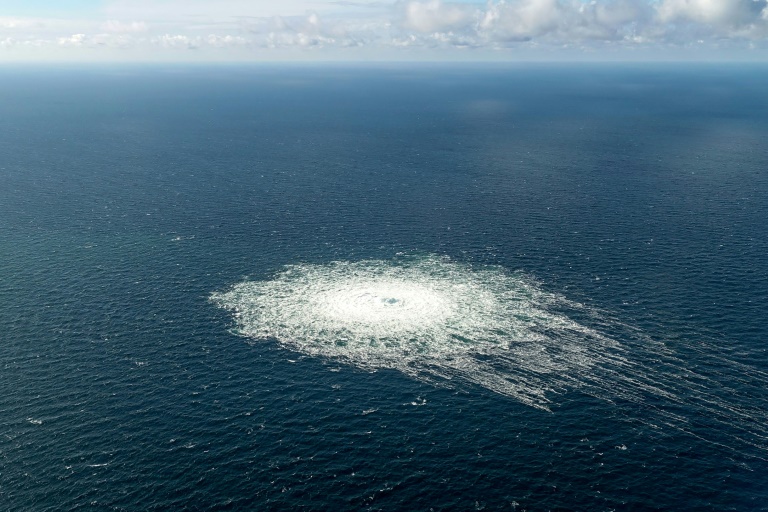large masses of bubbles on the surface of the water emanating from the three leaks located in Sweden's and Denmark's economic zones, spreading from 200 to 1,000 metres (656 feet to 0.62 miles) in diameter
Explosions were recorded before mysterious leaks in two Baltic Sea gas pipelines linking Russia and Europe, seismologists said Tuesday, raising suspicions of sabotage amid tensions over Moscow’s war in Ukraine.
Photos taken by the Danish military showed large masses of bubbles on the surface of the water emanating from the three leaks located in Sweden’s and Denmark’s economic zones, spreading from 200 to 1,000 metres (656 feet to 0.62 miles) in diameter.
“It’s hard to imagine that it’s accidental,” said Danish Prime Minister Mette Frederiksen, noting that it was “unusual” for the leaks to happen at such a distance from each other.
The Swedish National Seismic Network recorded two “massive releases of energy” shortly prior to the gas leaks and near their locations off the coast of the Danish island of Bornholm, Peter Schmidt, an Uppsala University seismologist told AFP.
“With energy releases this big there isn’t much else than a blast that could cause it,” he added. “You can see that they are quite sudden. It is a very sudden energy release. It’s not a slow collapse of something.”
Russia said earlier that it was “extremely concerned” about the leaks. Asked by reporters whether it could be an act of sabotage, Kremlin spokesman Dmitry Peskov said that at the moment “it is impossible to exclude any options”.
Ukraine, however, pointed the finger directly at Moscow, saying the incident was “nothing more than a terrorist attack planned by Russia and an act of aggression towards the EU”.
A White House officials said the United States would not speculate on the cause but was ready to support European efforts to investigate the leaks.
The Nord Stream 1 and 2 pipelines have been at the centre of geopolitical tensions in recent months as Russia cut gas supplies to Europe in suspected retaliation against Western sanctions following its invasion of Ukraine.
While the pipelines, which are operated by a consortium majority-owned by Russian gas giant Gazprom, are not currently in operation, they both still contain gas.
One of the leaks on Nord Stream 1 occurred in the Danish economic zone and the other in the Swedish economic zone, while the Nord Stream 2 leak was in the Danish economic zone.
A leak was first reported on Nord Stream 2 on Monday.
Danish climate and energy minister Dan Jorgensen confirmed the two Nord Stream 1 leaks in a statement to AFP on Tuesday.
“It is too early to say anything about the causes of the incidents,” the Danish Ministry of Climate, Energy and Utilities said in a statement.
Two Danish military vessels have been dispatched to the area, while Sweden called an emergency cabinet meeting to be held on Tuesday evening.
Navigational warnings have been issued for a distance of five nautical miles and a flight height of 1,000 metres (3,280 feet).
– ‘Extremely rare’ –
“Gas pipeline leaks are extremely rare and we therefore see a reason to increase the level of preparedness following the incidents we have witnessed over the past 24 hours,” Danish Energy Agency director Kristoffer Bottzauw said in a statement.
The European Commission said it was too early to speculate on the causes of the leaks.
“We believe we do not have the elements in order to determine what is the reason for the leak. And obviously any act of sabotage on any infrastructure is something that we would condemn,” commission spokesman Eric Mamer told reporters.
A Nord Stream spokesperson told AFP that they had not been able to assess the damage but conceded that “an incident where three pipes experience difficulties at the same time on the same day is not common.”
The Danish energy agency told the Ritzau news agency that only the area where the gas plume is located will be affected by the leak, but methane escaping into the atmosphere has a “climate-damaging effect”.
– ‘Targeted attack’ –
Built in parallel to the Nord Stream 1 pipeline, Nord Stream 2 was intended to double the capacity for Russian gas imports to Germany.
But Berlin blocked newly-completed Nord Stream 2 in the days before the war.
Germany, which has been highly dependent on imports of fossil fuels from Russia to meet its energy needs, has since come under acute stress as Moscow has dwindled supplies.
Russian energy giant Gazprom progressively reduced the volumes of gas being delivered via Nord Stream 1 until it shut the pipeline completely at the end of August, blaming Western sanctions for the delay of necessary repairs to the pipeline.
Germany has rebuffed Gazprom’s technical explanation for the cut, instead accusing Moscow of wielding energy as a weapon amid tensions over the war in Ukraine.
Meanwhile, German daily Tagesspiegel reported that the leaks might be the result of “targeted attacks”.
“We cannot imagine a scenario that is not a targeted attack,” a source close to the government and relevant authorities, was quoted as saying in the newspaper.









